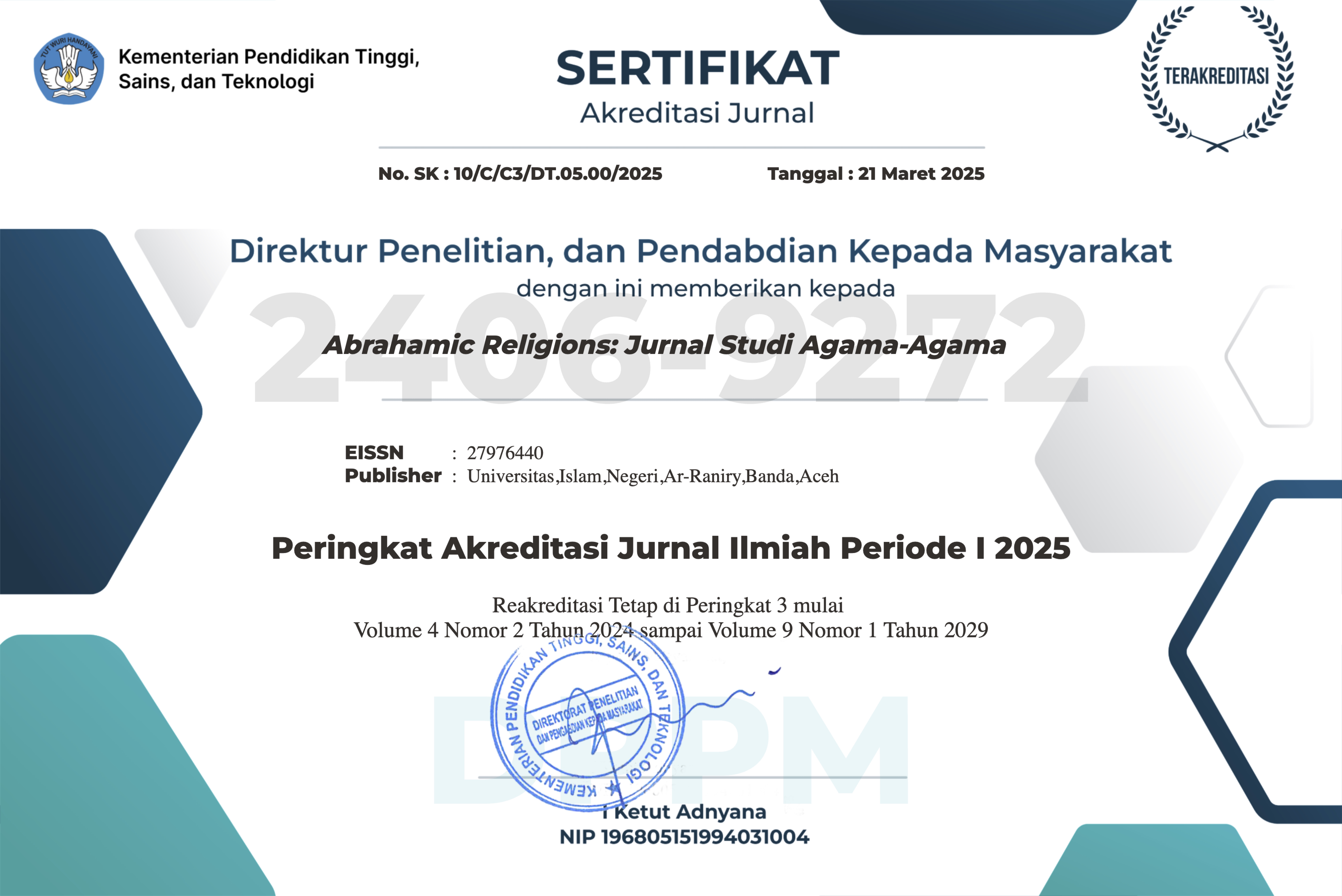STUDI KOMPARATIF KONSEP KENABIAN DALAM KITAB SUCI AL-QUR’AN, TANAKH, BIBEL DAN WEDA
DOI:
https://doi.org/10.22373/arj.v2i1.12426Keywords:
Prophet, Prophethood, Holy ScripturesAbstract
The concept of prophethood is an issue that is always relevant as long as society requires a comprehensive understanding of it, especially until now there are still emerging parties who claim to be prophets. This paper tries to explain the concept of Prophethood comprehensively with an explanation of the scriptures as a basic understanding of religions. This research uses literature and comparative studies as the method. That is by describing the concept of Prophethood in general and its concepts in the holy books of the Qur'an, Tanakh, Bible and Vedas and explaining the similarities and differences. The concept that has been described will eventually broaden people's understanding and strengthen unity and tolerance. The results of this paper are From the explanation above, it can be concluded that the four holy books (Al-Qur'an, Tanakh, Bible and Vedas have various concepts of prophethood. Comparative theology shows that the similarity of the concept of prophethood in the holy books lies in the superiority of a The prophet who differs from millions of other humans, in his prophetic role or role as well as who sent him. Meanwhile in terms of differences that the four holy books have their own concepts regarding the origin of the Prophet or his descendants, whether to be of Israelite blood or not. the concept of prophethood is also in the names of the Prophet as a personReferences
Affani, Syukron. 2017. “Rekonstruksi Kisah Nabo Musa Dalam Al-Qur’an: Studi Perbandingan Dengan Perjanjian Lama.” Jurnal Al-Ihkam 12(1):190.
Al-Ashfahani, Ar-Raghib. 2017. Kamus Al-Qur’an.
Al-Jazairi, Abu Bakar Jabir. 1978. Aqidah Al-Mukmin. Cairo: Al-Maktabah Al-Kulliyyah Al-Azhariyyah.
Al-Makin. 2017. Nabi-Nabi Nusantara: Kisah Lia Eden Dan Lainnya. Yogyakarta: Suka Press.
Al-Thabari. 2005. Jami’ Al-Bayan an Ta’wil Ayi Al Qur’an. Beirut: Dar Al-Fikr.
Al-Umuri, Akram Dhiya’. 20044. Seleksi Sirah Nabawiyah, Studi Kritis Muhadditsin Terhadap Riwayat Dhaif. Jakarta: Darul Falah.
Anon. 2017. Kamus Besar Bahasa Indonesia. Edisi ke-5. Jakarta: Kementerian Pendidikan dan Kebudayaan.
Badan Pusat Pengembangan Dan Pembinaan Bahasa. n.d. “‘Nabi,’ KBBI Online.” Retrieved June 19, 2021 (https://kbbi.web.id).
Glasse, Cyril. 2002. Ensiklopedi Islam (Ringkas). edited by terj. G. A.Mas’adi. Jakarta: PT. Raja Grafindo Persada.
Hasyim, Muh. Fathoni. 2019. “Rekonstruksi Tematik Atas Konsep Nabi Dan Misi Kenabian Dalam Alquran.” MUTAWATIR 9(2). doi: 10.15642/mutawatir.2019.9.2.256-277.
Hidayatullah, Tim Penulis IAIN Syarif. 1992. Ensiklopedi Islam Indonesia. Jakarta: Djambatan.
Ibrahim, Imam Asy-Syaukani and Sayyid. 2011. Tafsir Fathul Qadir. Jilid 5. Jakarta: Pustaka Azzam.
Katsir, Ibn. 2004. Lubaabub Tafsir Min Ibn Katsir. Bogor: Pustaka Imam Asy Syafi’i.
Kustono, Ant Hari. 2013. “Nabi Dan Mukjizat.” Jurnal Orientasi Baru 22(2):102.
Lexy J. Moleong, Dr. M. A. 2019. “Metodologi Penelitian Kualitatif (Edisi Revisi).” PT. Remaja Rosda Karya. doi: 10.1016/j.carbpol.2013.02.055.
M. Quraish Shihab. 1996. Wawasan Al-Qur’an: Tafsir Maudhui Atas Pelbagai Persoalan Umat. Bandung: Mizan.
Maire Byrne. 2011. The Names of God in Judaism, Christianity and Islam. London: Continuum International Publising Group.
Petersen, David L. 1981. The Roles of Israel’s Prophets. England: University of Sheffield.
Quthub, Sayyid. 2000. Tafsir Fi Zhilalil Qur’an: Dibawah Naungan Al-Quran. Jilid 24. Jakarta: Gema Insani Press.
RI, Depag. 2004. Al-Qur’an Dan Terjemahannya. Jakarta: PT Syamil Cipta Media.
RI, Direktorat Jendral Pendidikan Islam Kementerian Agama. 2019. Pendidikan Agama Islam Dan Budi Pekerti. Jakarta: Kementerian Agama Ri.
Shihab, M. Quraish. 2005. Tafsir Al-Misbah Pesan, Kesan Dan Keserasian Al-Qur’an. Jakarta: Lentera Hati.
Soepono, Langgeng Ichtiarsunu Yoyok. 2021. Wawancara. Ponorogo.
Sudarman. 2012. “Kritik Sosial Para Nabi: Studi Literatur Islam Dan Kristen.” IAIN Raden Intan Lampung.
Syaodih, Sukmadinata dan Nana. 2006. Metode Penelitian Pendidikan. Bandung: PT Remaja Rosdakarya.
Yusoff, Zulkifli Mohd, Abdul Rashid Bin Ahmad, Fauzi Deraman, Ishak Sulaiman, Mustaffa Abdullah, Faisal Ahmad Shah, Moh. Asmadi Yakob, Munirah, Monica Abd Razak, and Anwar Ridhwan Zakaria. 2009. “Kamus Al-Quran: Rujukan Lengkap Kosa Kata Dalam Al-Quran.” 1–699.
Zulaiha, Eni. 2017. “FENOMENA NABI DAN KENABIAN DALAM PERSPEKTIF ALQURAN.” Al-Bayan: Jurnal Studi Ilmu Al- Qur’an Dan Tafsir 1(2). doi: 10.15575/al-bayan.v1i2.1599.
Zulhamdani. 2017. “Interaksi Al-Qur’an Dengan Tradisi Pra-Quranik, Kritik, Atas Pemikiran Abraham Geiger Terhadap Imitatif Al-Qur’an.” Tafsere 5(1):23.
Downloads
Published
Issue
Section
License
Authors who publish in this Journal agree to the following terms:
- Authors retain copyright and grant the journal right of first publication with the work simultaneously licensed under Attribution-ShareAlike 4.0 International (CC BY-SA 4.0) allows others to share the work with an acknowledgment of the work's authorship and initial publication in this journal.
- Authors are able to enter into separate, additional contractual arrangements for the non-exclusive distribution of the journal's published version of the work (e.g., post it to an institutional repository or publish it in a book), with an acknowledgment of its initial publication in this journal.
- Authors are permitted and encouraged to post their work online (e.g., in institutional repositories or on their website) prior to and during the submission process, as it can lead to productive exchanges, as well as earlier and greater citation of published work. (See The Effect of Open Acces)















